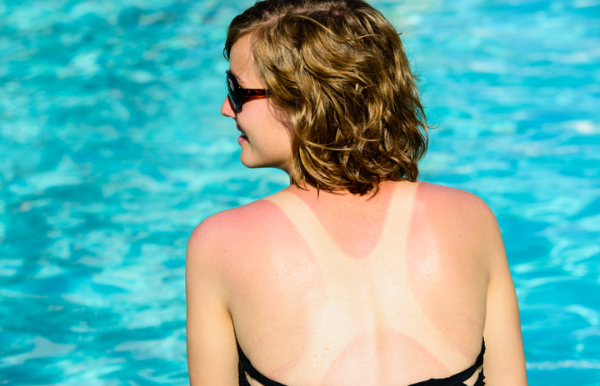
Sun poisoning vs. sunburn
The main difference between these two conditions is the severity. While a sunburn can be managed at home, sun poisoning poses a significant health risk and often requires medical attention. We’ll explore the differences between sunburn and sun poisoning, and how to treat the latter.
Quick links:
What is sun poisoning?
According to medical experts at Jackson Health System, sun poisoning is an acute sunburn resulting from excessive exposure to ultraviolet (UV) radiation, which provokes an extreme inflammatory reaction in the cells.
When the skin absorbs too many UV rays without adequate protection, the radiation overwhelms the body's defenses against sun damage. This brings on symptoms ranging from dizziness and fever to chills, blisters, and low blood pressure in severe cases.
In short, “sun poisoning” refers to a set of symptoms caused by a severe reaction to UV overexposure.
What is sunburn?
Sunburn refers to inflammation, redness, and irritation of the skin caused by too much exposure to ultraviolet rays from sunlight or artificial sources like tanning beds. According to the Skin Cancer Foundation, sunburn results when the amount of UV exposure exceeds the ability of the body's protective pigment, melanin, to shield the skin from damage.
While too much sun can be harmful to anyone, those with lighter skin are at greater risk for developing sunburn due to lower levels of melanin, compared to people with darker complexions. When the skin gets burnt from too much sun, it means the sun has damaged the skin cells, causing an immune reaction that manifests as swelling, redness, pain, and peeling skin.
The key differences between sun poisoning and sunburn
Even though sun poisoning and sunburn are caused by overexposure to UV radiation, they differ in their symptoms and treatment.
Symptoms of sun poisoning
Here are a few symptoms of severe sun poisoning to look out for:
- Skin redness is one of the earliest signs of sunburn—and of sun poisoning as well.
- Sun poisoning often leads to intense blistering. Sunburned skin may start peeling away in large, unbroken sheets, indicating a deeper level of skin damage.
- Individuals may experience a fever and chills, symptoms not typically associated with a mild sunburn. Dizziness and other heat-related symptoms may also manifest.
- Nausea, vomiting, upset stomach, and other flu-like symptoms can manifest.
- A rapid heartbeat or heart rate fluctuations, often with low blood pressure and shortness of breath.
- A sun poisoning rash can break out over large patches of skin.
- Some people may experience severe pain, while others may not.
If you notice any of these signs and symptoms, drink plenty of water, get out of the sun, and seek treatment as soon as possible.
Symptoms of sunburn
Sunburn is a precursor to sun poisoning. Some key sunburn symptoms to recognize include:
- Redness, pain, and tenderness.
- Warm skin and stinging or tightness last during the peak burn phase.
- Small to large fluid-filled blisters emerge in more affected areas.
- Peeling and itching occur as outer skin layers shed during healing.
- Headache, tiredness, and nausea sometimes follow a more moderate burn based on the body's stress response.
Mild sunburns generally peak in severity at 24-36 hours post-exposure to direct sunlight. While less serious than sun poisoning, repeated burns increase the risks of skin cancer.
How to treat sun poisoning
Milder cases of sun poisoning can be successfully treated at home. For more severe symptoms, you should go to the hospital. If in doubt, consult your doctor.
To treat sun poisoning at home, try the following approaches:
- Aloe vera is known for its soothing properties and can help in healing the skin. Apply aloe vera gel to the affected areas to provide relief.
- A cold bath or shower can help soothe the skin.
- Drink lots of water to aid in the body's recovery process.
- Protect the affected skin from additional sun exposure until it has fully healed. Stay indoors during peak sunlight hours or wear protective clothing and sunscreen if going outside is necessary.
If you go to an urgent care center for sun poisoning, they are likely to treat you with one or more of the following interventions:
- IV fluids for rehydration is one of the primary treatments for sun poisoning in a hospital setting is the administration of intravenous fluids. This is crucial for rehydrating the body, especially if the individual is showing signs of severe dehydration.
- Hydrocortisone cream or other steroid creams may be prescribed to reduce skin inflammation and soothe blistered or peeling skin.
- Depending on the severity, pain relievers can be administered to manage discomfort. If there is the added risk of an existing infection (especially in cases of severe skin blistering), antibiotics may be prescribed.
Causes of sunburn and sun poisoning
While both sunburn and sun poisoning stem from unprotected exposure to ultraviolet radiation from the sun or tanning beds, the extent of exposure differs.
Here are some common contributors to sun overexposure (sunburn and sun poisoning):
- Sun rays: UVA rays penetrate deeply into the skin, contributing to long-term skin damage and aging. UVB rays burn the skin's surface and can damage the DNA in skin cells. Excessive UV radiation can overpower the skin's melanin, which normally protects against sun damage.
- Reflection: surfaces like water, sand, and snow can reflect UV rays, increasing the intensity of exposure.
- UV index: peak sun hours cause sun poisoning much faster than early morning or late afternoon.
- Location: those in proximity to the equator experience stronger UV radiation.
- Environment: UV exposure is more intense at higher altitudes.
- Treatments: some medications can increase the skin's sensitivity to UV rays, increasing the risk of sun poisoning.
- Immune suppression: damaged skin cells can suppress the immune system, and the body's immune response to skin repair can be compromised, leading to sun poisoning.
- Skin type: those with lighter skin have less melanin which absorbs UV rays. This leaves them prone to quicker burning.
- Time outdoors: spending extended time recreationally in the sun without protection raises burn risk.
- Cloud cover: burns still happen on cloudy days when 80% of rays get through.
- Ozone depletion: less ozone means less protection from intense UV rays.
- Medications: some drugs like antibiotics make skin more sensitive to sun damage.
In most cases, sunburn symptoms do not immediately appear but the damage continues for hours after sun exposure.
Prevention of sun poisoning and sunburn
Prevent sun poisoning and sunburn with safe sun practices.
- Use a broad-spectrum sunscreen with a sun protection factor (SPF) of 30 or higher.
- Apply a generous amount of sunscreen to all exposed skin at least 20 minutes before going outdoors.
- Regularly reapply sunscreen, especially after swimming, sweating, or towel drying.
- Limit direct sunlight between 10 am-4 pm as the sun's rays are most intense during these hours.
- Use our handy UV index checker to see the ultraviolet intensity for your area, and take cover during more intense UV periods.
- Use wide-brimmed hats and UV-blocking sunglasses as additional protection for the face, neck, and eyes.
- Use one of our swim dresses with long sleeves to keep your upper body protected.
- Wear clothing that covers as much skin as possible, preferably with UV-protective fabric, to get an extra layer of defense against UV radiation.
- Gradually increase the amount of time spent in the sun to help the skin build a slight tolerance and reduce the risk of sun poisoning.
- Carry fluids for dehydration and cool compresses, especially in hot weather or when spending extended periods of time in the sun. Hydration also helps maintain skin health and aids in the body's overall heat regulation.
- Upgrade to sunglasses with 100% UVA/UVB blocking lenses for eye protection.
- Reschedule outdoor activities on days with very high UV index ratings to avoid intense exposure.
- Drink extra fluids before and after being outside to stay better hydrated.
- Take frequent breaks in shaded areas if engaging in extended sun activities such as sports, yardwork, or beach days.
- Know your limits and watch for early redness signaling it's time to get relief from the rays.
Stay safe with Swimzip’s protective gear
SwimZip's sun-protective beach gear features UPF 50+ fabric. It blocks 98% of harmful UVA and UVB rays for excellent defense against sun damage.
These garments deliver sun protection and come in a variety of styles that cater to both comfort and fashion preferences.
By choosing SwimZip, you're not just selecting a sun-protective clothing option; you're also embracing a lifestyle that prioritizes skin health without compromising style.
Whether you're planning a day at the beach or an outdoor adventure, we have the gear that makes sun protection a zip.
Sunburn vs. sun poisoning FAQ
How long does sun poisoning last?
Sun poisoning can last anywhere from a few days to a few weeks depending on the severity. In mild cases, symptoms may resolve within 5-7 days with appropriate at-home treatment. But, more extreme cases where blistering, fever, nausea, and dehydration occur could take 2-3 weeks to fully clear up. It depends on factors like the extent of exposure and how the individual's skin and immune system respond.
When should you go to the ER for a sunburn?
You should go to the emergency room for sunburn if you experience any of the following symptoms:
- High fever
- Loss of consciousness
- Confusion
- Severe pain
- Blisters covering a large surface area
- Oral temperature over 100°F
- Lack of improvement over a few days
- Signs of infection
These symptoms could indicate a major burn or sun poisoning that requires IV fluids, wound care, pain medications, and monitoring.
Will sun poisoning go away on its own?
Sun poisoning will typically not fully go away on its own without proper interventions. While some symptoms may initially improve after getting out of the sun, the skin and body need adequate hydration, wound care, pain relief, and infection prevention to properly heal. Severe cases can progress to life-threatening conditions without medical support like IV fluids to stabilize blood pressure, circulation, and organ function.
Will my skin go back to normal after sun poisoning?
In most cases, your skin will go back to normal after sun poisoning with proper care and time. The skin may peel and flake as it heals, which is part of the natural healing process. It's important to moisturize the skin and protect it from further UV exposure during the healing process.
Can you die from sun poisoning?
While sun poisoning itself is not usually fatal, severe cases can lead to complications that might be life-threatening if not treated properly. For example, extreme dehydration, electrolyte imbalances, or infections from blistering can pose serious health risks. There are rare cases where excessive sun exposure has become fatal, especially in individuals with pre-existing health conditions.
Why am I suddenly allergic to the sun?
Sudden sun allergies, such as Polymorphous Light Eruption (PMLE) or solar urticaria, can develop due to changes in your skin's sensitivity to UV radiation. This can be triggered by various factors, including certain medications, chemicals, or a change in your immune system's response to sunlight. These allergies result in rashes or other skin reactions shortly after sun exposure.
Does water help with sunburn?
Water can help with sunburn in several ways:
- Cool baths or showers can soothe the skin and reduce inflammation
- Cool, and damp compresses can provide relief
- Plenty of fluids are crucial to prevent dehydration, which can worsen the symptoms of sunburn
Note: direct application of ice or extremely cold water should be avoided as it can cause further skin irritation
What is the difference between sunstroke and sun poisoning?
Sunstroke, also known as heat stroke, is a condition caused by the body overheating, usually as a result of prolonged exposure to or physical exertion in high temperatures. It is a serious condition that affects the body's cooling system, leading to symptoms like high body temperature, altered mental state, and nausea.
Sun poisoning refers to a severe sunburn or an allergic reaction to the sun, leading to skin redness, blistering, and inflammation. While sunstroke affects the body's internal temperature regulation, sun poisoning primarily affects the skin.
How quickly does sun poisoning develop?
The symptoms of sun poisoning typically appear within a few hours to a few days after sun exposure. The severity of the symptoms can increase if you stay in the sun for a long time without protection. The symptoms usually peak after two to three days and then gradually improve over the next week or so.
Helpful information
UPF vs SPF: what is the difference?
Resources
Chien, A., & Kleiman, J. (n.d.). Sunburn. The Skin Cancer Foundation. Retrieved February 27, 2024, from https://www.skincancer.org/risk-factors/sunburn/
Sun Poisoning: Symptoms and Treatment. (n.d.). UHealth Jackson Urgent Care. Retrieved February 27, 2024, from https://jacksonurgentcare.com/illnesses/sun-poisoning/



Leave a comment
This site is protected by hCaptcha and the hCaptcha Privacy Policy and Terms of Service apply.